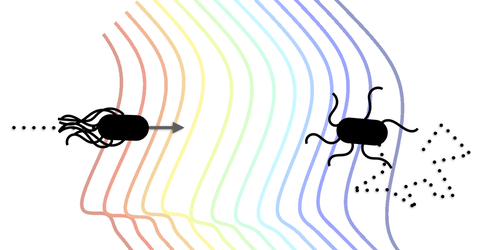Characterizing the Swimming Gait of a Bacterium
Escherichia coli is the lab rat of the microbial world. With strains that are beneficial to humans, and others that can kill us, researchers have probed every aspect of E. coli bacteria from their genetic information to their use as devices for rapidly replicating DNA molecules. Yet, an understanding of some aspects of their behavior has eluded scientists. Now Christina Kurzthaler of the Max Planck Institute for the Physics of Complex Systems, Germany; Yongfeng Zhao of Soochow University, China; and their colleagues have developed a method for probing one less-understood E. coli behavior—their swimming motion [1, 2]. Kurzthaler says that the method has the potential to become a standard tool for rapidly determining the swimming gait of microorganisms.
The team investigated various strains of the bacterium using a technique known as differential dynamic microscopy. Differential dynamic microscopy involves taking a sequence of microscope images of a plane within a bacterial suspension. Intensity changes between images reveal statistical information about the concentration of the bacterial population over time.
Kurzthaler, Zhao, and their colleagues realized that the technique could also be used to learn about the statistics of the locomotion phases of E. coli—“runs,” where bacteria move in a fixed direction, and “tumbles,” where they stay in one place while reorienting themselves. Extracting this information involved developing a fitting procedure for the experimental data using parameters derived from a theory of E. coli dynamics. With this fitting procedure the team derived short- and long-timescale motility parameters of three-dimensional samples without having to track each bacterium separately—a requirement of other techniques. Kurzthaler notes another advantage of their method that she says could aid in its uptake: it requires only a microscope, a standard piece of lab equipment, rather than specialized paraphernalia.
–Katherine Wright
Katherine Wright is the Deputy Editor of Physics Magazine.
References
- C. Kurzthaler et al., “Characterization and control of the run-and-tumble dynamics of Escherichia Coli,” Phys. Rev. Lett. 132, 038302 (2024).
- Y. Zhao et al., “Quantitative characterization of run-and-tumble statistics in bulk bacterial suspensions,” Phys. Rev. E 109, 014612 (2024).




